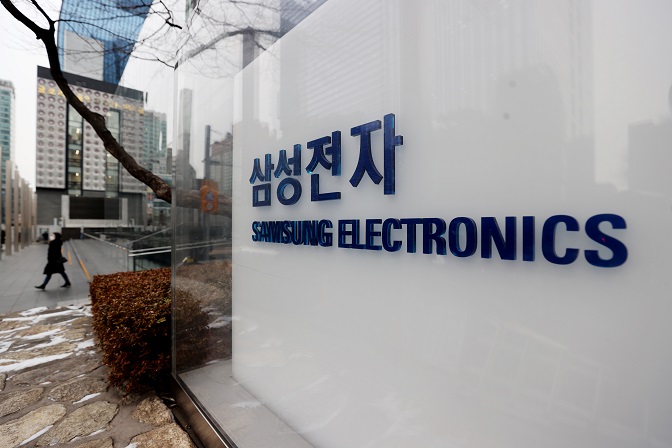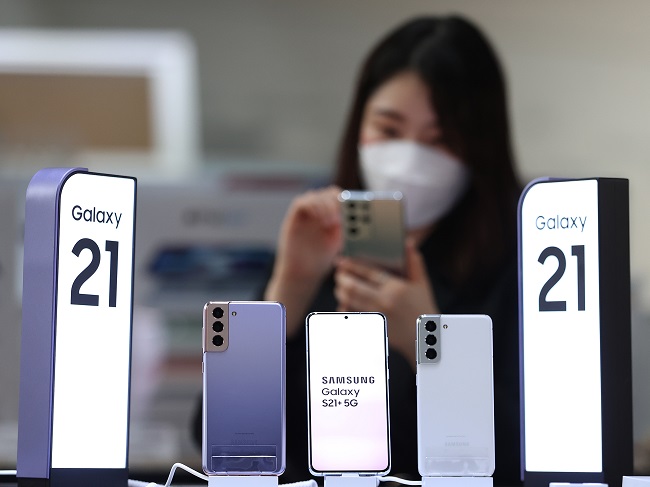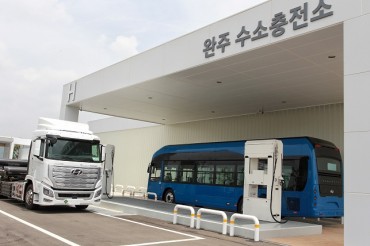
This file photo, taken on Jan. 18, 2021, shows the corporate signage of Samsung Electronics Co. at its office building in Seoul. (Yonhap)
SEOUL, Jan. 28 (Korea Bizwire) — Samsung Electronics Co. on Thursday said it expects downbeat first-quarter results on the weak U.S. dollar and uncertainties over the novel coronavirus pandemic after announcing a solid fourth-quarter performance, although demand for chips and smartphones will remain strong.
The company presented a conservative view on a so-called “super cycle” in the memory chip sector that many analysts have predicted to start this year.
The South Korean tech giant said its fourth-quarter net profit increased 26.4 percent on-year due to firm demand for chips and displays amid the pandemic.
The world’s leading memory chip and smartphone manufacturer said its net income stood at 6.6 trillion won (US$6 billion) in the October-December period, compared with 5.22 trillion won a year earlier.
Its operating profit jumped 26.35 percent on-year to 9.04 trillion won in the fourth quarter of 2020, while sales rose 2.78 percent to 61.55 trillion won over the cited period.
The figures were in line with its earnings guidance announced earlier this month.
But on a quarterly basis, Samsung’s fourth-quarter earnings were down from the third quarter performance, when it racked up record sales of 66.9 trillion won and an operating profit of 12.3 trillion won.
Samsung cited that weaker memory prices and sluggish consumer products sales, coupled with higher marketing costs and the Korean won’s appreciation against the greenback, dragged down its performance from the third quarter.
“The local currency’s value rose sharply against the U.S. dollar, euro and key emerging market currencies, resulting in a loss of about 1.4 trillion won compared with the previous quarter, mostly in semiconductor and display businesses,” it said.

This photo provided by Samsung Electronics Co. on May 21, 2020, shows the company’s chip plant in Pyeongtaek, south of Seoul.
For 2020, Samsung posted a net income of 26.4 trillion won, up 21.48 percent from a year ago, as its cash cow semiconductor business benefited from the stay-at-home trend caused by the novel coronavirus pandemic, while its end-product businesses, such as smartphones and home appliances, got a boost from pent-up demand when lockdowns were relaxed.
Samsung’s operating profit in 2020 stood at 35.99 trillion won, marking a 29.62 percent on-year increase, to log its fourth-largest operating income ever. Its revenue reached 236.8 trillion won last year, a 2.78 percent jump from 2019.
Looking ahead, Samsung expects its profitability to drop in the first quarter of 2021 due to currency effects and weak seasonality of its end-product businesses.
“The memory business will likely continue to be affected by the ongoing strength in the (Korean) won and costs associated with new production lines, despite solid demand from mobile products and data centers,” the company said.
For the whole of 2021, Samsung projected a recovery in overall global demand but emphasized that uncertainties still remain over the COVID-19 pandemic.
In the last three months of 2020, revenue from the semiconductor division stood at 18.18 trillion won, a 8.3 percent increase from a year earlier. Its operating profit from the chip business was 3.85 trillion won, up 11.6 percent over the cited period.
“Overall demand in the Memory Business was strong, led by continued strong mobile demand, as well as solid demand from data centers and PCs,” it said.

This file photo taken Jan. 15, 2021, shows Samsung Electronics Co.’s Galaxy S21 smartphones displayed at a store in Seoul. (Yonhap)
For DRAM, Samsung said its bit growth increased about 10 percent in the fourth quarter, but average selling price (ASP) declined in the upper single-digit percentage range.
Bit growth refers to the amount of memory produced and is considered a key barometer to gauge market demand.
Samsung said the overall market DRAM bit growth in the first quarter is estimated to fall in the mid single-digit percentage range but expected the company to perform better than the market level.
For NAND memory, Samsung said the bit growth grew to the upper single-digit percentage range, but its ASP dropped by just over 10 percent in the fourth quarter.
In the first quarter, Samsung projected that bit growth of the NAND market would rise by around 10 percent, and the company’s performance is expected to be similar to the market level.
Samsung said its memory business, specifically the DRAM market, is projected to see a recovery during the first half on the back of strong demand from mobile and server applications.
However, the company pointed out that global uncertainties remain, such as geopolitical risks, and that demand could fluctuate.
“Regarding a ‘big cycle’ in the industry like we saw between 2017 and 2018, we have to take a considerate stance,” said Han Jin-man, a senior vice president at Samsung’s memory business unit.
Samsung said its foundry business posted a new record quarterly revenue, thanks to robust demand for 5G chips and image sensors, though its profit also suffered a decline due to the foreign exchange impact.
The company projected foundry demand to remain strong in the first quarter and supply shortages to continue for the time being.
Samsung’s display panel business enjoyed its highest-ever quarterly earnings in the fourth quarter on the back of robust demand for smartphones and TVs amid an economic rebound.
The panel business division racked up 9.96 trillion won in sales in the fourth quarter, up 23.7 percent from a year ago, while operating profit marked an eightfold increase to 1.75 trillion won.
Samsung said OLED displays accounted for more than 80 percent of its panel sales last year, with its sales volume increasing by about 50 percent.
In the first quarter, Samsung expected its mobile display earnings to decline from a quarter earlier, but its utilization is projected to improve as more customers are adopting OLED displays for their products.
Samsung’s mobile business suffered a slump by posting sales of 22.34 trillion won in the fourth quarter, down 10.5 percent from a year earlier, while the unit’s operating profit slid 4 percent on-year to 2.42 trillion won.
“The mobile communications business saw revenue and profits decrease quarter-on-quarter on intensifying competition and higher marketing expenses,” it said.
“However, the company maintained a double-digit profit margin by improving the cost structure through measures, such as component standardization.”
In a conference call, Samsung said it sold 67 million units of handsets in the fourth quarter, down from 88 million units in the previous quarter, with more than 90 percent of them being smartphones.
Its tablet sales reached 10 million units, up from 9 million units in the third quarter.
Its blended ASP, including tablets, was $205 in the fourth quarter, down $24 from the previous three months.
Looking ahead to the first quarter, Samsung said market demand for smartphones and tablets is expected to decline compared with the previous quarter, but both revenue and profit for its mobile business are expected to rise on the back of its new Galaxy S21 smartphone series and improved product mix.
Samsung’s Consumer Electronics (CE) business division reported an increase in fourth-quarter earnings, with sales rising 7 percent on-year to 13.61 trillion won and operating profit increasing 1.2 percent on-year to 820 billion won.
Samsung, the world’s TV maker, said its fourth-quarter TV shipments increased slightly from the previous quarter, thanks to strong year-end demand in advanced markets.
However, the company expected its first-quarter TV shipments to plunge by more than 20 percent due to weak seasonal demand.
For its digital appliances business, Samsung said the market demand increased amid the at-home trend caused by the COVID-19 pandemic.
“Flexible peak season promotions and premium product sales drove profits higher than last year, in both advanced and emerging markets, including India and Latin America,” it said.
For this year, the company expected the appliances market to grow from pent-up demand in advanced markets.
Share in Samsung fell 2.22 percent to 83,700 won on the Seoul bourse, underperforming the broader KOSPI’s 1.71 percent decline. Its fourth-quarter earnings results were released before the stock market opened.
(Yonhap)







